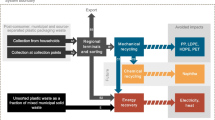Abstract
Many life cycle assessment studies have evaluated and compared the environmental performance of various technologies for recycling plastic containers and packaging in Japan and other countries. However, no studies have evaluated the combination of recycling technologies in consideration of the resin composition in terms of the quantity of each recycled product so as to maximize their environmental potential. In this study, 27 scenarios of recycling schemes for household waste plastic containers and packaging are developed through integrating a conventional recycling scheme with additional recycling schemes. The conventional recycling scheme involves municipal curbside collection and either the material recycling or feedstock recycling of waste plastics. The additional recycling schemes are feedstock recycling in steel works of the residue from conventional material recycling processes, and corporate voluntary collection and independent material recycling of specific types of plastic trays. Life cycle assessment based on the modeling of recycling processes considering the resin composition in terms of the quantity of each recycled product is applied to evaluate and compare these scenarios from the viewpoints of fossil resource consumption and CO2 emission. The results show that the environmental loads are reduced in all scenarios including the additional recycling schemes compared with the conventional recycling scheme. However, the independent plastic tray recycling scheme exhibits lower additional environmental savings when the residue recycling scheme is integrated with the conventional material recycling scheme. This is because both additional recycling schemes aim to utilize polystyrene and polyethylene terephthalate, which would otherwise be incinerated as residue from material recycling processes. The evaluation of the environmental loads of plastic recycling with consideration of the resin composition in terms of the quantity of each recycled product makes it possible to investigate recycling schemes that integrate different technologies to maximize their environmental potential.





Similar content being viewed by others
References
Plastic Waste Management Institute (2010) Plastic products, plastic waste and resource recovery. PWMI Newsletter No. 39 (in Japanese)
The Japan Plastic Containers and Packaging Recycling Association. http://www.jcpra.or.jp/eng/index.html. Accessed 28 Dec 2010 (in Japanese)
Moriguchi Y (2005) Plastic waste issues from the viewpoint of a sound material-cycle society. Haikibutsu gakkaishi 16(5):243–252 (in Japanese)
Ministry of the Environment and Ministry of Economy, Trade and Industry, Government of Japan (2010) Council documents (in Japanese)
Arena U, Mastellone ML, Perugini F (2003) Life cycle assessment of a plastic packaging recycling system. Int J LCA 8(2):92–98
Perugini F, Mastellone ML, Arena U (2005) A life cycle assessment of material and feedstock recycling options for management of plastic packaging wastes. Process Integr 24(2):137–154
Molgaard C (1995) Environmental impacts by disposal of plastic from municipal solid waste. Resour Conservat Recycl 15(1):51–63
Amelia LC, Jane CP (1996) Lifecycle assessment and economic evaluation of recycling: a case study. Resour Conserv Recycl 17(2):75–96
Wollny V, Dehoust G, Fritsche UR, Weinem P (2002) Comparison of plastic packaging waste management options—feedstock recycling versus energy recovery in Germany. J Ind Ecol 5(3):49–63
Eriksson O, Reich MC, Frostell B, Bjorklund A, Assefa G, Sundqvist JO, Granath J, Baky A, Thyselius L (2005) Municipal solid waste management from a systems perspective. J Cleaner Prod 13(3):241–252
Finnveden G, Johansson J, Lind P, Moberg A (2005) Life cycle assessment of energy from solid waste—part 1: general methodology and results. J Cleaner Prod 13(3):213–229
Inaba R, Hashimoto S, Moriguchi Y (2005) Life cycle assessment of recycling in the steel industry for plastic containers and packaging—influence of system boundary. Haikibutsu gakkai ronbunshi 16(6):467–480 (in Japanese)
Nakatani J, Aramaki T, Hanaki K (2007) Multi-aspect impact assessment of plastics waste management: a case study of Kawasaki city. Kankyokagakukaishi 20(3):181–194 (in Japanese)
The Japan Plastic Containers and Packaging Recycling Association (2007) Environmental assessment of recycling technologies for plastic containers and packaging (in Japanese)
Plastic Waste Management Institute (2006) Eco-efficiency in management of plastic containers and packaging (in Japanese)
Plastic Waste Management Institute (2008) Feasibility assessment of material recycling of plastic containers and packaging based on life cycle assessment (in Japanese)
Sekine Y, Fukuda K, Kato K, Adachi Y, Matsuno Y (2009) CO2 reduction potentials by utilizing waste plastics in steel works. Int J Life Cycle Assess 14(2):122–136
Larsen AW, Merrild H, Møller J, Christensen TH (2010) Waste collection systems for recyclables: an environmental and economic assessment for the municipality of Aarhus (Denmark). Waste Manag 30:744–754
Nakatani J, Fujii M, Moriguchi Y, Hirao M (2010) Life-cycle assessment of domestic and transboundary recycling of post-consumer PET bottles. Int J Life Cycle Assess 15:590–597
Kato K, Nomura S, Uematsu H (2003) Waste plastics recycling process using coke ovens. J Mater Cycles Waste Manag 5(2):98–101
Fukushima M, Shioya M, Wakai K, Ibe H (2009) Toward maximizing the recycling rate in a Sapporo waste plastics liquefaction plant. J Mater Cycles Waste Manag 11(1):11–18
Fukushima M, Beil W, Ibe H, Wakai K, Sugiyama E, Abe H, Kitagawa K, Tsuruga S, Shimura K, Ono E (2010) Study on dechlorination technology for municipal waste plastics containing polyvinyl chloride and polyethylene terephthalate. J Mater Cycles Waste Manag 12(2):108–122
National Institute for Environmental Studies (in Japanese) http://www-cycle.nies.go.jp/precycle/index.html. Accessed on 28 Dec 2010
Ministry of the Environment and Ministry of Economy, Trade and Industry, Government of Japan (2007) Council documents (in Japanese)
Ministry of the Environment, Government of Japan (2003) Field survey on disposal of containers and packaging wastes (in Japanese)
Matsuto T, Tanaka N (2000) Estimation of household waste flow. Haikibutsu gakkai ronbunshi 11(4):214–223 (in Japanese)
Matsuto T (2005) Analysis, planning, and assessment for management system of municipal waste. Gihodo syuppan, Tokyo (in Japanese)
Japan Environmental Management Association for Industry (2004) JLCA-LCA database 2004Fy, 2nd edn (in Japanese)
Acknowledgments
The authors are grateful to the anonymous Japanese recyclers who provided valuable information.
Author information
Authors and Affiliations
Corresponding author
Rights and permissions
About this article
Cite this article
Nishijima, A., Nakatani, J., Yamamoto, K. et al. Life cycle assessment of integrated recycling schemes for plastic containers and packaging with consideration of resin composition. J Mater Cycles Waste Manag 14, 52–64 (2012). https://doi.org/10.1007/s10163-011-0032-y
Received:
Accepted:
Published:
Issue Date:
DOI: https://doi.org/10.1007/s10163-011-0032-y




